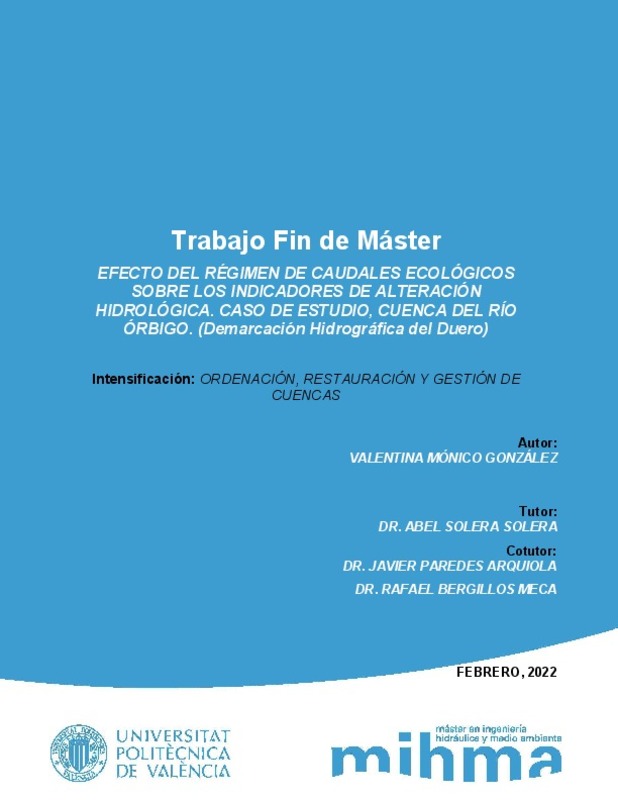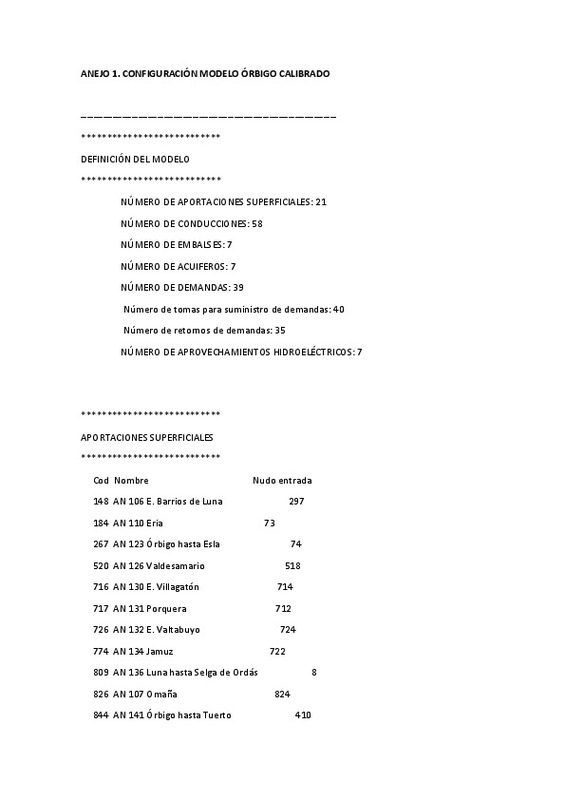|
Resumen:
|
[ES] En la gestión del agua cada vez es más común hablar sobre impacto ambiental debido a la actividad humana y sus consecuencias sobre el medio ambiente, así como las medidas que se deberían tomar para mitigar, en mayor ...[+]
[ES] En la gestión del agua cada vez es más común hablar sobre impacto ambiental debido a la actividad humana y sus consecuencias sobre el medio ambiente, así como las medidas que se deberían tomar para mitigar, en mayor o menor medida, ese impacto. Y si se tiene en cuenta que gran parte del éxito en la conservación y funcionalidad de los ríos y la biodiversidad depende del régimen natural de caudales, se entiende que las medidas más importantes son las que se toman a la hora de gestionar una cuenca. Es aquí donde la planificación hidrológica tiene un papel fundamental.
En la actualidad, existen diferentes metodologías para estimar la alteración que sufre un ecosistema frente a una intervención antrópica y en las cuales se apoya la planificación hidrológica en la toma de decisiones. Estas metodologías, suelen estimar el impacto a escala local y dependiendo de la naturaleza de la intervención y de los datos disponibles pueden llegar a ser muy complejas. El trabajo hace una recopilación del estado del arte del régimen de caudales ecológicos y la alteración hidrológica, así como de las metodologías más importantes para evaluarla.
Una vez se cuenta con las bases teóricas y teniendo como punto de partida la caracterización del sistema y los objetivos de planificación, se busca establecer una metodología que permita hacer uso de los índices de alteración hidrológica y de diferentes herramientas tecnológicas. Esto con el fin de valorar el impacto de las diferentes medidas de gestión, sobre el estado general de la cuenca y poder valorar el grado de cumplimiento de estos objetivos.
Esta metodología permite en primera instancia establecer la condición de referencia de la cuenca y caracterizar el régimen natural de caudales en esta condición. Buscando conocer los diferentes elementos del régimen de caudales y su interacción con el ecosistema. Adicionalmente, valora la alteración del régimen de caudales por medio de 35 indicadores simplificados en seis índices de alteración hidrológica.
Uno de los puntos más importantes a considerar dentro de la metodología propuesta, es la utilización de datos diarios de aportaciones. Esto teniendo en cuenta que el análisis de la gestión de cuencas se realiza a escala mensual, y esto dificulta el contraste con los indicadores hidrológicos. Por otro lado, los datos diarios permiten diferenciar eventos de gran importancia para el ecosistema, como las crecidas.
Finalmente, se ha aplicado esta metodología a la cuenca del río Órbigo, que hace parte del sistema fluvial del Duero y que abastece a cerca de 156 603 personas y 68 318 ha de regadíos al año. Para validar su uso y mostrar la utilidad que tendrá para la toma de decisiones.
[-]
[EN] In water management, it is increasingly common to speak of environmental impact due to human activity and it is consequences on the environment, as well as the measures that must be taken to mitigate, to a greater or ...[+]
[EN] In water management, it is increasingly common to speak of environmental impact due to human activity and it is consequences on the environment, as well as the measures that must be taken to mitigate, to a greater or lesser extent, this impact. And if one considers that much of the success in the conservation and functionality of rivers and biodiversity depends on the natural flow regime, it is understood that the most important measures are those taken when managing a basin. This is where hydrological planning plays a key role.
At present, there are different methodologies to estimate the alteration suffered by an ecosystem in the face of anthropic intervention and on which hydrological planning is based in decision-making. These methodologies often estimate impact at the local level and, depending on the nature of the intervention and the data available, can be very complex. This work makes a compilation of the state of the art of the regime of ecological flows and hydrological alteration, as well as the most important methodologies to evaluate it.
Once the theoretical bases have been established and having as a starting point the characterization of the system and the planning objectives, we seek to establish a methodology that allows the use of hydrological alteration indices and different technological tools. This in order to evaluate the impact of the different management measures on the general state of the basin and to be able to evaluate the degree of fulfilment of these objectives.
This methodology allows in the first instance to establish the basin reference condition and characterize the natural flow regime in this condition. Seeking to know the different elements of the flow regime and its interaction with the ecosystem. Additionally, it evaluates the alteration of the flow regime through 33 simplified indicators in six indices of hydrological alteration.
One of the most important points to consider within the proposed methodology is the use of daily input data, since the analysis of watershed management is carried out on a monthly scale, and this makes difficult to contrast with hydrological indicators. On the other hand, daily data make it possible to differentiate events of great importance to the ecosystem, such as floods.
Finally, this methodology has been applied to the Órbigo river basin, which is part of the Duero River system and supplies about 156,603 people and 68,318 hectares of irrigated land per year, to validate its use and show the usefulness it will have for decision making.
[-]
|








